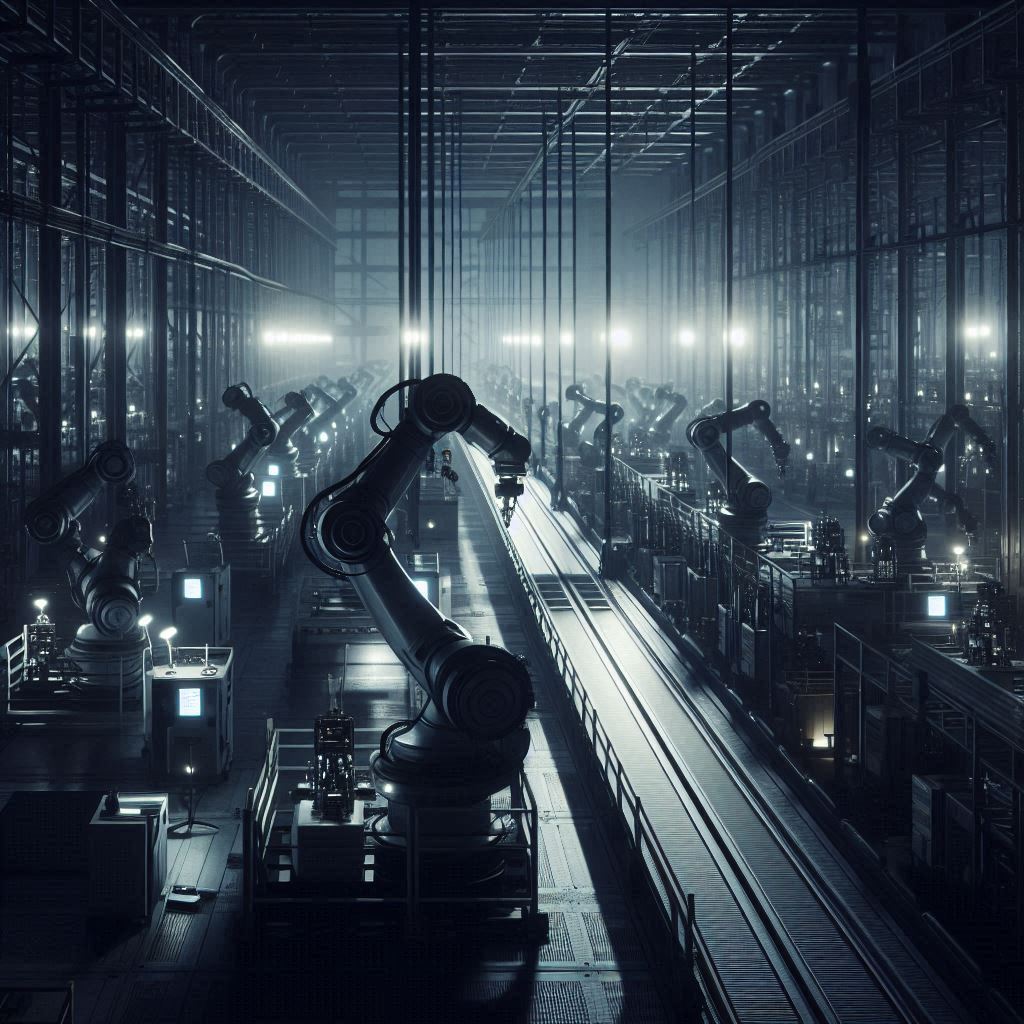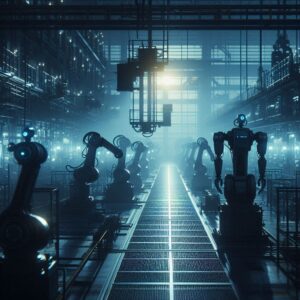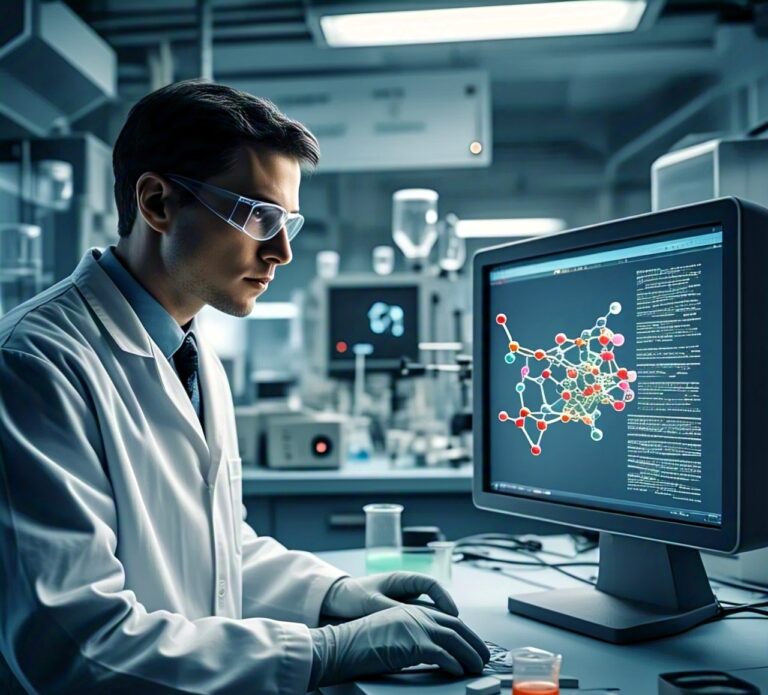Dark Factories: The Quiet Revolution of Robot Rule
Automation is transforming the manufacturing industry, and at the heart of this evolution lies a groundbreaking concept: dark factories. The quiet revolution of robot rule. These fully autonomous facilities operate without human intervention, often in complete darkness, leveraging cutting-edge technologies like artificial intelligence (AI), robotics, and the Internet of Things (IoT). This quiet revolution is reshaping global production, promising unprecedented efficiency and cost savings while raising critical questions about the future of human labour.

What Are Dark Factories?
Dark factories, also known as “lights-out factories,” are manufacturing plants designed to operate 24/7 without requiring human presence. By utilizing advanced robotics and interconnected IoT systems, these facilities eliminate the need for lighting or on-site workers. The result is a streamlined, cost-effective production environment capable of delivering consistent product quality while minimizing operational expenses135.
Key Features of Dark Factories
-
Full Automation: Robots handle tasks such as assembly, material handling, and quality control with precision and speed.
-
IoT Integration: Sensors and connected devices monitor operations in real time, enabling predictive maintenance and reducing downtime.
-
Energy Efficiency: Operating in darkness reduces energy consumption, contributing to sustainability goals.
-
Scalability: These factories can easily adapt to increased production demands without requiring additional workforce15.
The Technologies Powering Dark Factories

The rise of dark factories is fueled by several technological advancements:
- Industrial Robots: These machines perform repetitive tasks with high accuracy, while collaborative robots (cobots) enhance safety by working alongside humans when needed5.
- Artificial Intelligence: AI optimizes production processes by analyzing vast data sets and predicting maintenance needs3.
- Digital Twins: Virtual simulations of factory operations allow manufacturers to test and optimize workflows without disrupting production5.
- Big Data Analytics: Insights derived from data improve efficiency and reduce costs5.
Real-World Examples
Companies like Wootzano in the UK are leading the way in dark factory operations. Their robot-powered packing lines prepare and package fruit with minimal supervision, showcasing the potential for near-total automation in food processing. Similarly, Japanese robotics giant Fanuc has been running a lights-out factory since 2001, where robots manufacture other robots at an astonishing pace37.
Benefits of Dark Factories
The advantages of dark factories extend beyond cost savings:
-
Increased Productivity: Robots can work continuously without breaks or fatigue.
-
Enhanced Precision: Automation reduces human error, ensuring consistent product quality.
-
Cost Reduction: Lower energy usage and minimal labour costs contribute to significant savings.
-
Supply Chain Resilience: Autonomous operations mitigate disruptions caused by labour shortages or global crises13.
Challenges and Ethical Considerations
Despite their promise, dark factories face several challenges:
-
Complexity in Customization: Fully automated systems struggle with highly customized or intricate products5.
-
Job Displacement: The reduction in human roles raises concerns about unemployment and economic inequality.
-
Initial Costs: Setting up a dark factory requires substantial investment in technology and infrastructure.
Elon Musk’s admission that “excessive automation was a mistake” highlights the limitations of robots in problem-solving and creative thinking. Many manufacturers are adopting a “lights-sparse” approach, combining automation with human oversight for more complex tasks37.
Do you agree or disagree? Let’s start a debate—drop your opinion in the comments!
The Future of Manufacturing
Dark factories represent a seismic shift in how goods are produced. As technology continues to advance, these facilities will likely become more prevalent across industries ranging from electronics to automotive manufacturing. However, balancing automation with human involvement will be crucial to address ethical concerns and ensure sustainable growth.
Dark factories ensure product quality without human oversight through the integration of advanced technologies that enable real-time monitoring, precision, and consistency. Key methods include:
-
AI-Driven Quality Control: Artificial intelligence (AI) and machine learning algorithms analyze production data to detect anomalies and predict potential defects before they occur. These systems can continuously learn and improve, ensuring consistent product quality136.
-
Computer Vision Systems: High-resolution cameras and computer vision technologies inspect products for defects during manufacturing. These systems can identify minute imperfections that might be missed by human inspectors, ensuring high precision56.
-
IoT Sensors and Predictive Analytics: Internet of Things (IoT) devices collect real-time data on machinery performance and product specifications. Predictive analytics use this data to optimize processes and maintain consistent quality standards14.
-
Digital Twins: Virtual replicas of the manufacturing process simulate operations to identify inefficiencies or potential issues. This allows manufacturers to refine workflows without disrupting production16.
-
Robotic Precision: Industrial robots perform tasks with unparalleled accuracy, reducing variability in production and ensuring uniformity across products23.
These technologies collectively enable dark factories to maintain high-quality production standards while operating autonomously, minimizing human error and maximizing efficiency.
The operation of dark factories is driven by a combination of advanced technologies that enable fully autonomous and efficient production. Here are the main technologies powering these facilities:
Robotics and Automation
-
Industrial Robots: These robots handle repetitive tasks like assembly, welding, and material handling with high precision and speed.
-
Collaborative Robots (Cobots): Designed to work alongside humans when needed, cobots enhance flexibility in partially automated environments12.
Artificial Intelligence (AI) and Machine Learning
-
AI optimizes production processes by analyzing vast datasets, predicting maintenance needs, and improving decision-making.
-
Machine learning algorithms enable systems to adapt and improve over time, ensuring consistent product quality123.
Internet of Things (IoT)
-
IoT sensors collect real-time data on machinery performance, environmental conditions, and production metrics.
-
This data is used for predictive maintenance, reducing downtime and ensuring operational efficiency124.
Digital Twins
-
Virtual replicas of physical systems simulate factory operations, allowing manufacturers to monitor and optimize workflows without disrupting production.
-
Digital twins enhance predictive capabilities and streamline troubleshooting13.
Big Data Analytics
-
Advanced analytics uncover patterns in production data to improve efficiency, reduce costs, and identify potential issues before they escalate14.
Vision Systems
-
Computer vision technology inspects products for defects during manufacturing, ensuring high-quality standards without human oversight23.
Autonomous Guided Vehicles (AGVs)
-
AGVs transport materials within the factory using pre-programmed routes and navigation systems, eliminating the need for human-operated forklifts23.
These technologies work in concert to create a seamless, self-sustaining production environment that defines the essence of dark factories. By leveraging these advancements, manufacturers achieve higher productivity, precision, and cost savings while minimizing human intervention.
The use of artificial intelligence (AI) in dark factories has revolutionized manufacturing, but it also comes with significant limitations that impact its effectiveness and scalability. Here are the primary challenges:
Primary Challenges of Dark Factories
Lack of Flexibility
AI systems excel at repetitive and predefined tasks but struggle with non-standard or highly customized processes. Unlike human workers, machines require extensive reprogramming to adapt to new production needs, making them less agile in dynamic manufacturing environments12.
High Initial Costs
Implementing AI-driven automation in dark factories demands substantial upfront investments in infrastructure, robotics, and software development. These costs can be prohibitive for smaller manufacturers, limiting widespread adoption1.
Dependence on Data Quality
AI relies heavily on high-quality data for training and operation. Poor or biased data can lead to inaccurate predictions, defects in production, or inefficiencies, undermining the reliability of the system35.
- Vulnerability to Technical Failures
While AI reduces human error, it is not immune to malfunctions. A single technical failure in an automated system can halt production entirely, leading to costly downtime and delays14.
- Cybersecurity Risks
Dark factories are highly interconnected through IoT devices and AI systems, making them vulnerable to cyberattacks. A breach could disrupt operations or compromise sensitive data, posing significant risks to manufacturers15.
- Ethical and Regulatory Concerns
The opacity of AI decision-making processes (“black box” problem) raises ethical questions about accountability and transparency. Additionally, regulatory frameworks for AI use in manufacturing are still evolving, creating uncertainty for businesses36.
- Shortage of Skilled Workers
Although dark factories reduce the need for manual labour, they require highly skilled technicians to design, implement, and maintain AI systems. The global shortage of such expertise is a bottleneck for scaling these operations24.
These limitations highlight the need for a balanced approach where AI complements human expertise rather than entirely replacing it. Hybrid models that combine automation with human oversight may provide a more sustainable path forward for the manufacturing industry.
The rise of dark factories has sparked several ethical concerns, particularly regarding their impact on society, labour, and the environment. Here are the key ethical issues associated with these fully automated manufacturing facilities:
key Ethical Issues Associated with Dark Factories
Job Displacement and Economic Inequality
-
Loss of Employment: Dark factories eliminate the need for human workers in many roles, leading to widespread unemployment, especially in industries reliant on manual labor. This displacement disproportionately affects low-income and less-skilled workers, exacerbating economic inequality12.
-
Unequal Wealth Distribution: Automation benefits corporations by reducing costs, but it risks concentrating wealth among business owners and shareholders while leaving displaced workers struggling to find alternative employment3.
Workforce Reskilling Challenges
-
Skill Gaps: Transitioning to automated systems requires a workforce skilled in robotics, AI, and IoT technologies. Many workers lack access to training programs or resources for reskilling, creating barriers to reentry into the workforce14.
-
Ethical Responsibility: Businesses face ethical pressure to invest in reskilling initiatives and support displaced workers through career transitions.
Environmental Concerns
-
While dark factories can reduce energy consumption by operating without lighting or heating, they may still contribute to environmental issues such as electronic waste from robotics and pollution from automated systems34. Balancing efficiency with sustainability remains a critical ethical challenge.
Cybersecurity Risks
-
The reliance on interconnected IoT systems makes dark factories vulnerable to cyberattacks. A breach could disrupt operations and compromise sensitive data, raising ethical questions about safeguarding digital infrastructure4.
Regulatory and Governance Issues
-
Lack of Oversight: The rapid adoption of automation often outpaces regulatory frameworks, leaving gaps in governance around safety standards and worker protections2.
-
AI Accountability: Ethical concerns arise over the “black box” nature of AI decision-making in production processes. Transparency and accountability are essential but often lacking4.
Social Alienation
-
The absence of human workers in dark factories creates a sense of alienation from the production process. This disconnect raises concerns about the societal implications of removing human involvement from industries that traditionally relied on labour-intensive work23.
Addressing these ethical concerns requires collaboration between governments, businesses, and communities. Policymakers must implement regulations to protect displaced workers and ensure sustainable practices, while companies should prioritize workforce reskilling and transparency in automation adoption.
Industries currently leading in the adoption of dark factories are those that benefit most from automation, precision, and scalability. Here are the key sectors driving this revolution:
key Sectors Driving this Revolution
Electronics Manufacturing
-
Leaders: Companies like Siemens and Xiaomi are pioneering dark factory operations in electronics production, leveraging AI and robotics to achieve high precision and efficiency12.
-
Why: The complexity and standardization of electronic components make them ideal for fully automated production lines.
Automotive Industry
-
Leaders: Tesla is advancing automation in its Gigafactories, while Geely Monjaro in China has implemented dark factory concepts for vehicle production12.
-
Why: Robotics streamline assembly, welding, and painting processes, reducing costs and ensuring scalability.
Precision Engineering
-
Leaders: CNC machining facilities in China have adopted lights-out manufacturing for precision engineering tasks12.
-
Why: High accuracy and repeatability are critical for industries like aerospace and medical device manufacturing.
Consumer Goods
-
Leaders: Adidas introduced Speedfactories in Germany and the USA to automate sneaker production using robotics and AI12.
-
Why: Automation ensures faster production cycles for standardized goods like clothing and footwear.
Pharmaceutical Industry
-
Leaders: Emerging dark factory models focus on drug formulation, packaging, and quality control3.
-
Why: These facilities maintain strict hygiene standards while ensuring consistent product quality.
Food Processing
-
Leaders: Companies like Wootzano use robotic systems to pack perishable items with minimal human intervention12.
-
Why: Automation enhances hygiene, efficiency, and scalability in food production.
- Logistics and Warehousing
-
Leaders: Autonomous guided vehicles (AGVs) are increasingly used in warehouses for inventory management and order fulfillment3.
-
Why: Fully automated logistics hubs optimize operations while reducing labour dependency.
Key Players and Regions in Automation and AI-driven Manufacturing
Companies:
-
Fanuc (Japan): Known for its fully automated facility in Japan, where robots produce other robots without human intervention1.
-
Siemens (Germany): Siemens has integrated dark factory operations into its electronic manufacturing division, achieving high-quality production rates1.
-
Tesla (USA): While not fully autonomous yet, Tesla is pushing towards automation in its Gigafactories intending to achieve fully autonomous production1.
-
Foxconn and BYD (China): These companies are at the forefront of China’s automation efforts, with Foxconn replacing thousands of workers with robots5.
Regions:
-
China: China is rapidly adopting dark factories, driven by the “Made in China 2025” initiative. It leads in industrial robot installations and is positioning itself as a global leader in automation58.
-
Japan: Japan, particularly with companies like Fanuc, has been a pioneer in implementing dark factory concepts1.
-
Germany: Companies like Siemens are driving the adoption of dark factories in Europe1.
Startups and Innovators:
- Wootzano: Known for advanced robotics in dark factory settings6.
- Basetwo AI: Specializes in digital twins for optimizing factory operations6.
- Geofabrica: Focuses on large-scale 3D printing for dark factory applications6.
These leaders are driving innovation and growth in the dark factory market, which is expected to expand significantly over the coming years23.
AI Contributes to the Success of these Fully Automated Facilities:
Predictive Maintenance
-
AI-powered predictive maintenance systems monitor equipment performance in real time, identifying potential failures before they occur. This reduces downtime by over 50% in some cases and ensures uninterrupted production12.
-
Machine learning models analyze historical and current data to forecast maintenance needs, minimizing costly repairs1.
Quality Control
-
AI systems use computer vision and machine learning algorithms to inspect products for defects with high precision, significantly reducing error rates12.
-
For example, convolutional neural networks optimize processes like plastic injection moulding, cutting defect rates by up to 66%1.
Process Optimization
-
AI-driven digital twins simulate manufacturing processes, enabling real-time adjustments to optimize yield, throughput, and resource efficiency13.
-
Advanced algorithms adjust parameters dynamically during production, such as in sheet metal forming or chemical manufacturing, leading to material savings and improved cycle times1.
Energy Efficiency
-
AI helps manage energy consumption by analyzing operational data and optimizing resource use, achieving reductions in emissions and operational costs12.
-
Smart systems can operate in complete darkness, further lowering energy requirements.
Scalability and Customization
-
AI enables rapid scaling of production while maintaining consistency. It also facilitates customization by adapting workflows for specific product designs without manual intervention23.
Workforce Empowerment
-
While dark factories minimize human involvement, AI-guided systems empower workers in hybrid setups by providing actionable insights and automating repetitive tasks1.
By integrating these capabilities, AI transforms dark factories into highly efficient, self-sustaining production hubs. The technology not only enhances operational performance but also sets new benchmarks for sustainability and innovation across industries.
Pros of Dark Factories
Increased Efficiency and Productivity
-
Dark factories operate 24/7 without breaks, significantly boosting production output.
-
Advanced robotics and AI systems optimize processes continuously, reducing waste and improving efficiency.
Cost Reduction
-
Elimination of labour costs for many roles leads to substantial long-term savings.
-
Energy efficiency improves as these facilities can operate without lighting or heating for human comfort.
Improved Quality Control
-
AI-powered inspection systems detect defects with higher accuracy than human workers, ensuring consistent product quality.
-
Precision robotics minimizes errors in production processes.
Enhanced Safety
-
Dangerous or repetitive tasks are handled by robots, reducing workplace accidents and injuries.
Scalability
-
Dark factories can easily adapt to increased production demands without the need to hire and train new workers.
Cons of Dark Factories
High Initial Investment
-
Setting up a dark factory requires substantial upfront costs for advanced robotics, AI systems, and infrastructure.
Job Displacement
-
Widespread adoption of dark factories could lead to significant job losses in manufacturing sectors, potentially exacerbating economic inequality.
Limited Flexibility
-
While efficient for standardized production, dark factories may struggle with highly customized or frequently changing product lines.
Technical Vulnerabilities
-
Reliance on interconnected IoT devices and AI systems makes dark factories susceptible to cyberattacks and technical failures.
Skill Gap
-
The transition to dark factories creates a demand for highly skilled technicians to design, implement, and maintain complex automated systems, which may be challenging to fulfill.
Ethical Concerns
-
The rapid automation of manufacturing raises questions about the societal impact of reduced human involvement in production processes.
As the dark factories market is projected to grow from $47.26 billion in 2025 to $76.43 billion by 20321, industries will need to carefully weigh these pros and cons when considering the implementation of fully automated manufacturing facilities.
Citations:
- https://www.coherentmarketinsights.com/industry-reports/dark-factories-market
- https://www.einnews.com/pr_news/783941157/dark-factories-market-is-booming-worldwide-2025-2032-amazon-clevertech-wootzano
- https://www.wns.com/perspectives/articles/articledetail/1368/the-future-of-manufacturing-5-trends-defining-2025
- https://www.openpr.com/news/3806115/global-dark-factories-market-size-2025-emerging-demands-share
- https://explodingtopics.com/blog/manufacturing-trends
- https://www.einnews.com/pr_news/778610960/dark-factories-market-set-to-witness-significant-growth-by-2025-2032-amazon-clevertech
- https://www.capgemini.com/insights/expert-perspectives/dark-factories-bright-future/
- https://www.webfx.com/industries/industrial/manufacturing/manufacturing-industry-trends/
Qwen 2.5: Alibaba’s New AI Model Surpasses DeepSeek-V3
